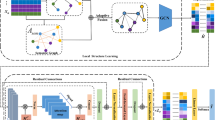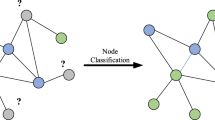Abstract
The task of social network alignment is to identify the user nodes which are active in multiple social networks simultaneously, thus the information from multiple social networks can be integrated to conduct some downstream tasks. Existing network alignment methods mostly establish anchor link prediction models using user profile information or the structural similarities in social networks, which may not effectively model user nodes, thus affecting the effectiveness of social network alignment. This paper focuses on social network alignment by modeling user nodes based on the structural information of irregular graphs and multi-dimensional user features. Specially, Graph Neural Networks (GNNs) models and bi-layer graph attention mechanism are designed to learn the embedding vectors of user nodes in social networks. First, multi-dimensional user features are comprehensively modeled. Then, a user-layer attention mechanism and a feature-layer attention mechanism based on GNN are respectively designed to learn the embedding vectors of user nodes, and the embedding vectors of user nodes in social networks are learned by designing a gated neural network to automatically learn the weight parameters of the user-layer embedding vectors and the feature-layer embedding vectors. Finally, based on the embedding vectors, a bi-directional alignment strategy is proposed to predict the anchor links between the source and target social networks, thus to ensure which meet the constraints of one-to-one alignment relationship. Simulation experiments based on multiple real social network datasets prove that our proposed method achieves better results in metrics of Accuracy and F1 than the existing mainstream social network alignment methods.









Similar content being viewed by others
References
Kong X, Zhang J, Yu PS (2013) Inferring anchor links across multiple heterogeneous social networks. In: Proc. of the 22nd ACM CIKM, pp. 179–188
Zhang J, Chen J, Zhi S, Chang Y, Yu PS, Han J (2017) Link prediction across aligned networks with sparse and low rank matrix estimation. In: IEEE 33rd ICDE, pp. 971–982
Lu C-T, Xie S, Shao W, He L, Yu PS (2016) Item recommendation for emerging online businesses. In: Proc. of the 25th IJCAI, pp. 3797–3803
Zhan Q, Zhang J, Wang S, Yu PS, Xie J (2015) Influence maximization across partially aligned heterogeneous social networks. In: Proc. of Advances in Knowledge Discovery and Data Mining. Springer International Publishing, pp 58–69
Wu J, Zhao Z, Sun Q, Hamido F (2021) A maximum self-esteem degree based feedback mechanism for group consensus reaching with the distributed linguistic trust propagation in social network. Inf Fusion 67:80–93
Zhang J, Yu PS (2015) Integrated anchor and social link predictions across social networks. In: Proc. of the 24th International Conference on Artificial Intelligence, Buenos Aires, Argentina, pp. 2125–2131
Zhang J, Yu PS (2015) Multiple anonymized social networks alignment. In: Proc. of the 2015 ICDM, Washington, DC, USA, pp. 599–608
Liu J, Zhang F, Song X, Song Y-I, Lin C-Y, Hon H-W (2013) What’s in a name?: An unsupervised approach to link users across communities. In: Proc. of the Sixth ACM WSDM, New York, NY, USA, pp. 495–504
Liu S, Wang S, Zhu F, Zhang J, Krishnan R (2014) HYDRA: Large-scale social identity linkage via heterogeneous behavior modeling. In: Proc. of the 2014 ACM SIGMOD, New York, NY, USA, pp. 51–62
Tan S, Guan Z, Cai D, Qin X, Bu J, Chen C (2014) Mapping users across networks by manifold alignment on hypergraph. In: Proc. of the 28th AAAI, Québec city, Québec, Canada, pp. 159–165
Zhang H, Kan M-Y, Liu Y, Ma S (2014) Online social network profile linkage. In: Asia Information Retrieval Symposium. Springer International Publishing, pp 197–208
Zhou X, Liang X, Zhang H, Ma Y (Feb. 2016) Cross-platform identification of anonymous identical users in multiple social media networks. IEEE Trans Knowl Data Eng 28(2):411–424
Liu L, Cheung WK, Li X, Liao L (2016) Aligning users across social networks using network embedding. In: Proc. of the 25th IJCAI, New York, USA, pp. 1774–1780
Zhang W, Shu K, Liu H, Wang Y (2019) Graph neural networks for user identity linkage, ArXiv190302174 Cs
Zhao W, Tan S, Guan Z, Zhang B, Gong M, Cao Z, Wang Q (Dec. 2018) Learning to map social network users by unified manifold alignment on hypergraph. IEEE Trans Neural Netw Learn Syst 29(12):5834–5846
Zhang Y, Tang J, Yang Z, Pei J, Yu PS (2015) COSNET: Connecting heterogeneous social networks with local and global consistency. In: Proc. of the 21th ACM SIGKDD, New York, USA, pp. 1485–1494
Zhou X, Liang X, Du X, Zhao J (Jun. 2018) Structure based user identification across social networks. IEEE Trans Knowl Data Eng 30(6):1178–1191
Xie W, Mu X, Lee RK-W, Zhu F, Lim E-P (2018) Unsupervised user identity linkage via factoid embedding. In: 2018 ICDM, pp. 1338–1343
Zafarani R, Tang L, Liu H (Oct. 2015) User identification across social media. ACM Trans Knowl Discov Data 10(2):16:1–16:30
Feng S, Shen D, Nie T, Kou Y, He J, Yu G (2018) Inferring anchor links based on social network structure. IEEE Access 6:17340–17353
Qu Y, Sun Z, Hu W, Zhang Q (2018) Bootstrapping entity alignment with knowledge graph embedding. In: 2018 IJCAI, pp. 4396–4402
Cheng A, Liu C-Y, Zhou C, Tan J, Guo L (2018) User alignment via structural interaction and propagation. In: 2018 IJCNN, pp. 1–8
Huynh TT, Tong VV, Duong CT, Huynh Quyet T, Nguyen QVH, Sattar A (2019) Network alignment by representation learning on structure and attribute. In: PRICAI 2019: Trends in Artificial Intelligence, Cham, pp. 698–711
Fu S, Wang G, Xia S, Liu L (2020) Deep multi-granularity graph embedding for user identity linkage across social networks. Knowl-Based Syst 193:105301
Li X, Cao Y, Shang Y, Li Y, Liu Y, Tan J (2021) RLINK: deep reinforcement learning for user identity linkage. World Wide Web 24:85–103
Zhang J et al (2018) MEgo2Vec: Embedding matched ego networks for user alignment across social networks. In: Proc. of the 27th ACM CIKM, New York, NY, USA, pp. 327–336
Zhou F, Wen Z, Zhong T, Trajcevski G, Liu L (2020) Unsupervised user identity linkage via graph neural networks. In: Proc. 2020 IEEE global communications conference. IEEE
Bahdanau D, Cho K, Bengio Y (May 2016) Neural machine translation by jointly learning to align and translate. ArXiv14090473 Cs stat
Hu H, Zhang Z, Xie Z, Lin S (Apr. 2019) Local relation networks for image recognition, ArXiv190411491 Cs
Yu S, Wang Y, Yang M, Li B, Qu Q, Shen J (2019) NAIRS: A neural attentive interpretable recommendation system. In: Proc. of the 12th ACM WSDM, New York, NY, USA, pp. 790–793
J. Lu, J. Yang, D. Batra, and D. Parikh, (2016) Hierarchical question-image co-attention for visual question answering, in advances in neural information processing systems 29, Eds. Curran Associates, Inc., pp. 289–297
Le QV, Mikolov T (May 2014) Distributed representations of sentences and documents. In: 2014 International Conference on Machine Learning, pp. 1188–1196
Veličković P, Cucurull G, Casanova A, Romero A, Liò P, Bengio Y (Feb. 2018) Graph attention networks, ArXiv171010903 Cs stat
Wang D, Cui P, Zhu W (2016) Structural deep network embedding, In: Proc. of the 22nd ACM SIGKDD, New York, NY, USA, pp. 1225–1234
Heimann M, Shen H, Safavi T, Koutra D (2018) REGAL: Representation learning-based graph alignment. In: Proc. 27th ACM –CIKM, pp. 117–126
Man T, Shen H, Liu S, Jin X, Cheng X (2016) Predict anchor links across social networks via an embedding approach. In: Proc. of the 25th IJCAI, New York, USA, pp. 1823–1829
Author information
Authors and Affiliations
Corresponding author
Additional information
Publisher’s note
Springer Nature remains neutral with regard to jurisdictional claims in published maps and institutional affiliations.
Rights and permissions
About this article
Cite this article
Lu, M., Dai, Y. & Zhang, Z. Social network alignment: a bi-layer graph attention neural networks based method. Appl Intell 52, 16310–16333 (2022). https://doi.org/10.1007/s10489-022-03216-w
Accepted:
Published:
Issue Date:
DOI: https://doi.org/10.1007/s10489-022-03216-w




